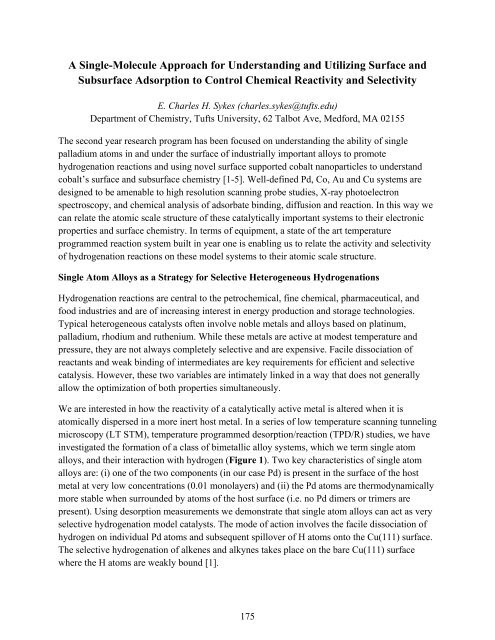Eighth Condensed Phase and Interfacial Molecular Science (CPIMS)
Eighth Condensed Phase and Interfacial Molecular Science (CPIMS)
Eighth Condensed Phase and Interfacial Molecular Science (CPIMS)
You also want an ePaper? Increase the reach of your titles
YUMPU automatically turns print PDFs into web optimized ePapers that Google loves.
A Single-Molecule Approach for Underst<strong>and</strong>ing <strong>and</strong> Utilizing Surface <strong>and</strong><br />
Subsurface Adsorption to Control Chemical Reactivity <strong>and</strong> Selectivity<br />
E. Charles H. Sykes (charles.sykes@tufts.edu)<br />
Department of Chemistry, Tufts University, 62 Talbot Ave, Medford, MA 02155<br />
The second year research program has been focused on underst<strong>and</strong>ing the ability of single<br />
palladium atoms in <strong>and</strong> under the surface of industrially important alloys to promote<br />
hydrogenation reactions <strong>and</strong> using novel surface supported cobalt nanoparticles to underst<strong>and</strong><br />
cobalt’s surface <strong>and</strong> subsurface chemistry [1-5]. Well-defined Pd, Co, Au <strong>and</strong> Cu systems are<br />
designed to be amenable to high resolution scanning probe studies, X-ray photoelectron<br />
spectroscopy, <strong>and</strong> chemical analysis of adsorbate binding, diffusion <strong>and</strong> reaction. In this way we<br />
can relate the atomic scale structure of these catalytically important systems to their electronic<br />
properties <strong>and</strong> surface chemistry. In terms of equipment, a state of the art temperature<br />
programmed reaction system built in year one is enabling us to relate the activity <strong>and</strong> selectivity<br />
of hydrogenation reactions on these model systems to their atomic scale structure.<br />
Single Atom Alloys as a Strategy for Selective Heterogeneous Hydrogenations<br />
Hydrogenation reactions are central to the petrochemical, fine chemical, pharmaceutical, <strong>and</strong><br />
food industries <strong>and</strong> are of increasing interest in energy production <strong>and</strong> storage technologies.<br />
Typical heterogeneous catalysts often involve noble metals <strong>and</strong> alloys based on platinum,<br />
palladium, rhodium <strong>and</strong> ruthenium. While these metals are active at modest temperature <strong>and</strong><br />
pressure, they are not always completely selective <strong>and</strong> are expensive. Facile dissociation of<br />
reactants <strong>and</strong> weak binding of intermediates are key requirements for efficient <strong>and</strong> selective<br />
catalysis. However, these two variables are intimately linked in a way that does not generally<br />
allow the optimization of both properties simultaneously.<br />
We are interested in how the reactivity of a catalytically active metal is altered when it is<br />
atomically dispersed in a more inert host metal. In a series of low temperature scanning tunneling<br />
microscopy (LT STM), temperature programmed desorption/reaction (TPD/R) studies, we have<br />
investigated the formation of a class of bimetallic alloy systems, which we term single atom<br />
alloys, <strong>and</strong> their interaction with hydrogen (Figure 1). Two key characteristics of single atom<br />
alloys are: (i) one of the two components (in our case Pd) is present in the surface of the host<br />
metal at very low concentrations (0.01 monolayers) <strong>and</strong> (ii) the Pd atoms are thermodynamically<br />
more stable when surrounded by atoms of the host surface (i.e. no Pd dimers or trimers are<br />
present). Using desorption measurements we demonstrate that single atom alloys can act as very<br />
selective hydrogenation model catalysts. The mode of action involves the facile dissociation of<br />
hydrogen on individual Pd atoms <strong>and</strong> subsequent spillover of H atoms onto the Cu(111) surface.<br />
The selective hydrogenation of alkenes <strong>and</strong> alkynes takes place on the bare Cu(111) surface<br />
where the H atoms are weakly bound [1].<br />
175
















